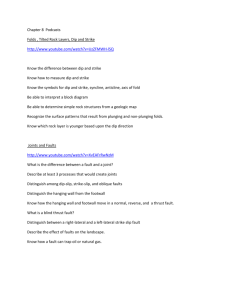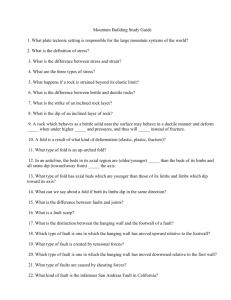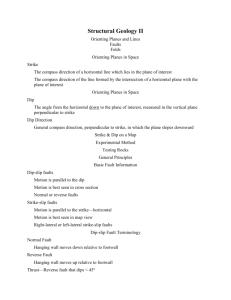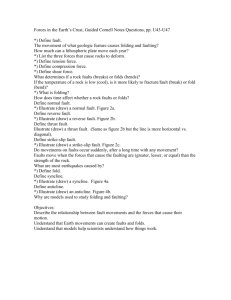Geologic Structures
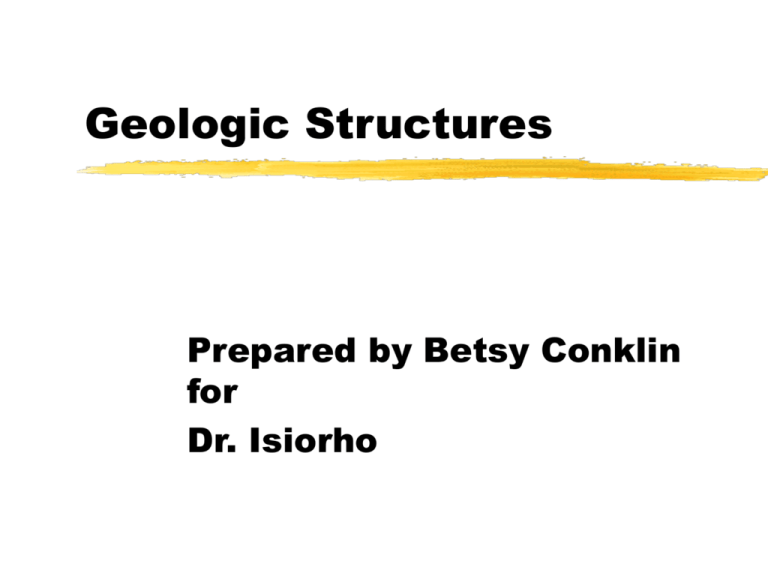
Geologic Structures Prepared by Betsy Conklin for Dr. Isiorho
Tectonic Forces at Work
structural geology: the branch of geology concerned with the shapes, arrangement, and interrelationships of bedrock units and the forces that cause them stress: a force per unit area strain: the change in size (volume) or shape, or both, while an object is undergoing stress
Stress and Strain in the Earth’s Crust
compressive stress: a stress due to a force pushing together on a body
Stress and Strain in the Earth’s Crust
tensional stress: caused by forces pulling away from one another in opposite directions
Stress and Strain in the Earth’s Crust
shear stress: due to movement prallel to but in opposite directions along a fulat or other boundary
Behavior of Rocks to Stress and Strain
elastic strain: strain in which a deformed body recovers its original shape after the stress is released (ex: rubber band) elastic limit: the maximum amount of stress that can be applied to a body before it deforms in a permanent way by bending or breaking ductile: capable of being molded and bent under stress brittle strain: cracking or rupturing of a body under stress
Present Deformation of the Crust
Geologists often say the crust of the earth is “mobile” or “restless” because bedrock is moving and being deformed in many parts of the world fault: a fracture in bedrock along which movement has taken place
Geologic Maps and Field Methods
geologic map: a map which uses standardized symbols and patterns to represent rock types and geologic structures that is typically produced from the field map for a given area geologic cross section: represents a vertical slice through a portion of the earth
Strike and Dip
strike: the compass direction of a line formed by the intersection of an inclined plane with a horizontal plane angle of dip: a measurement downward from the horizontal plane to the bedding plane direction of dip: the compass direction in which the angle of dip is measured
Folds
fold: bends or wave-like features in layered rock anticline: an upward arching fold hinge line: the axis of the fold syncline: a downward-arching counterpart of an anticline axial plane: a plane containing all of the hinge lines of a fold
Plunging Folds
plunging folds: folds in which the hinge lines are not horizontal Plunging folds: anticline on left and right, syncline in center. The hinge lines are at an angle to the block diagram, penetrating the surface and emerging from the front cross section
Structural Domes and Structural Basins
structural dome: a structure in which the beds dip away from a central point structural basin: a structure in which the beds dip toward a central point Structural basin Structural dome
Interpreting folds
open folds: a fold with gently dipping limbs isoclinal fold: a fold in which the limbs are parallel to one another overturned fold: a fold in which both limbs dip in the same direction recumbent fold: a fold overturned to such an extent that the limbs are essentially horizontal
Interpreting folds & Unconformities
Fractures in Rock
joint: a fracture or crack in bedrock where essentially no displacement occurs joint set: where joints are oriented approximately parallel to one another
Faults
dip-slip fault: movement is parallel to the dip of the fault surface strike-slip fault: horizontal motion parallel to the strike of the fault surface oblique-slip fault: both strike-slip and dip-slip components
Dip-Slip Faults
footwall: the underlying surface of an inclined fault plane hanging wall: the overlying surface of an inclined fault plane
Dip-Slip Faults (cont.)
normal fault: a fault where the hanging-wall block has moved downward relative to the footwall block graben: when a block bounded by normal faults drops down horst: when a block bounded by normal faults is uplifted
Dip-Slip Faults (cont.)
reverse fault: when the hanging-wall block has moved upward relative to the footwall block thrust fault: a reverse fault in which the dip of the fault plane is at a low angle to horizontal A reverse fault. The fault is unaffected by erosion.
Arrows indicate compressive stress.
Diagram shows area after erosion; dashed lines indicate portion eroded away Thrust fault due to horizontal compression.
Strike-slip Faults
strike-slip fault: a fault where the movement is predominantly horizontal and parallel to the strike of the fault right-lateral fault: a strike-slip fault in which the block seen across the fault appears displaced to the right left-lateral fault: a strike-slip fault in which the block seen across the fault appears displaced to the left
Pictures
All pictures used in this power point presentation were taken from the following: Carlson, Diane H., David McGeary and Charles C. Plummer. Physical Geology: Updated Eighth Edition . New York City, McGraw-Hill Higher Education, 2001 .
